Getting Started (Lon)
So you've decided to give Legends of Norrath a try. That's great, and we're here to help. There are a few things you need to know before you get started. First up is the cards. We'll show you what the different types are, what they do, and what all the icons mean. Then we'll talk about the turn sequence and how to play your cards.
There are 6 card types in the game and each has its own important function. The six types are Avatar, Quest, Ability, Item, Unit, and Tactic. We'll cover all 6 and breakdown what everything on them means.
| Contents [hide] |
Avatars
First up is the avatar. Let's take a look at what an avatar looks like.
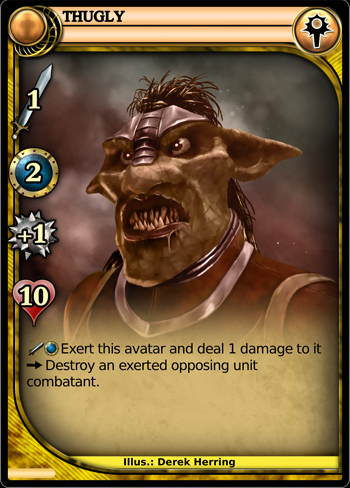
Avatars are unique in that you get to create your own custom avatars. There are several that come in the starter decks, but if you don't like their stats, race, archetype, power or whatever, you can just create your own by going into the deckbuilder and choosing the "Create Avatar" button. Now let's look at everything that comes with an avatar.
The first thing in the top center is simply the name of the card. This is pretty self-explanatory.
In the top right corner of the card is an icon that denotes the card's archetype . There are four archetypes in LoN. Fighter, Mage, Priest, and Scout. This avatar is a Priest which means he will only be able to use cards that also have the Priest icon. Some cards do not have an archetype. Most units along with some other cards do not have an archetype. They are generic cards and can be used by any archetype.
Down the left side of the card you will notice four icons. These are the stats that your avatar will use while in combat.
The first number, indicated by the sword, is the Attack Strength of your avatar. When your avatar is attacking, if it is ready, you may exert it to add its attack value to your overall attack. We'll go into greater detail about how combat works when we get to the turn sequence.
The second number, indicated by the shield, is the Defense Strength of your avatar. When your avatar is defending, if it is ready, you may exert it to add its defense value to your overall defense.
The third number, indicated by the spiked ball, is the Damage Bonus of your avatar. At the end of a successful combat involving your avatar, if it is still ready, you can exert it to add its damage bonus to the total damage that will be dealt in the combat. Again, we will be discussing combat in greater detail when we get to the turn sequence.
The fourth number, indicated by the heart, is your hero's Health. When your avatar loses a combat or is dealt damage through other means, its health will go down by the amount of that damage. If your avatar's health reaches 0, you lose so it's important to keep them healthy.
Next, there is the text box directly below the picture. All avatars have a special ability. The text box is where the special ability will be listed along with any other important game text.
Quests
The next card type is Quests. Each deck has 4 quests. The Quests are separate from the rest of the deck and are put into play in the same order every game as they are completed. Each deck must have exactly one level 2 Quest, one level 4 Quest, one level 5 Quest, and one level 6 Quest. Both players will start with their level 2 Quest in play. When a player completes a Quest, he or she puts their next quest into play in place of the one just completed. You can win the game by completing 4 Quests. Here's an example of a Quest.
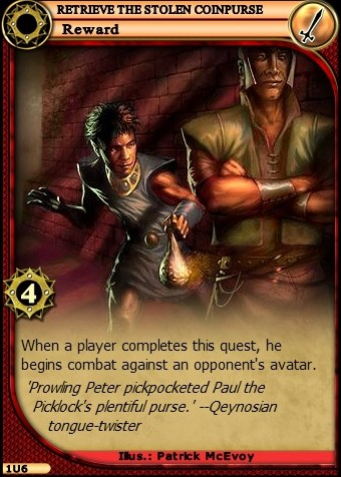
There's not quite as much going on with the quest as the avatar, but they are still very important. In the top left corner of the card, you will notice the gold gears type icon. That shows that this card is a Quest. In the top left corner is the Archetype icon. This quest can only be included in a Fighter deck.
On the left side of the card is the level of the quest. This is a level 4 Quest which means it takes 4 level tokens to complete it. We will talk more about completing quests when we get to the turn sequence in a little while.
Finally there is the text box. Again, any additional game text or special abilities will be in this text box.
Abilities
The next type of card is an Ability. Let's take a look at one.
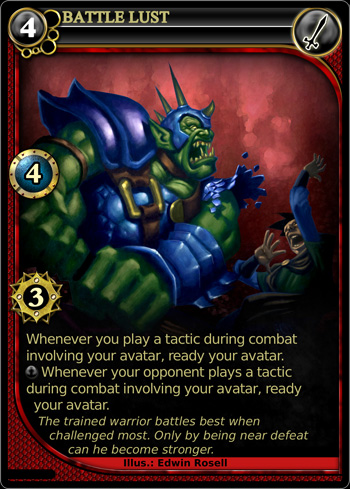
In the top left corner there are three important things on this card. The first is the number 4. This represents the cost to play this card. For this card it costs 4 power to be able to put it into play. All cards other than your avatar and quests will have a cost.
The is inside a small circle. The color of that circle represents the Faction of the card. There are three possibilities for faction. Shadow, Light, and Neutral. This card is black which represents Shadow faction. Neutral is a peach color and Light will have a white circle.
The final and often overlooked icon in the top left corner is the card type icon. The small circles around the outside of the faction circle tell you this card is an ability. You won't need to look at this often as it's generally pretty easy to tell the difference between cards, but sometimes there are cards that aren't 100% clear.
Moving over to the top right corner we have the archetype icon. The sword on this one again symbolizes the Fighter archetype. Like quests, abilities can only be played by the appropriate archetype unless they are generic.
Moving down the left hand side, we see 2 numbers. The first is the Defense Strength of the ability represented by the shield. When your avatar is defending, you can exert an ability to add its defense value to your total defense. Not all abilities have a defense value.
The second number on top of the icon for quests is how many levels this ability has. When you attempt a quest, you will apply an ability at that quest. For every level the ability you apply has, you will place one level token at the quest. When you place tokens equal to the level of the quest, that quest will become completed and will be replaced by the next highest quest you have left. If you complete 4 quests in one game, you win.
Finally, we have the text box again. You'll notice in this text box, there is an added effect with a little black circle in front of it. As you play cards with the Shadow and Light faction alignments throughout the game, you will gain faction in each. Once you reach a certain level you become Shadow faction or Light faction. Some cards give additional bonuses once you have reached Shadow or Light faction. The black circle in front of the second half of this card means that effect kicks in once you've reached Shadow faction.
Items
Next up is Items. Let's take a look at a couple of items.
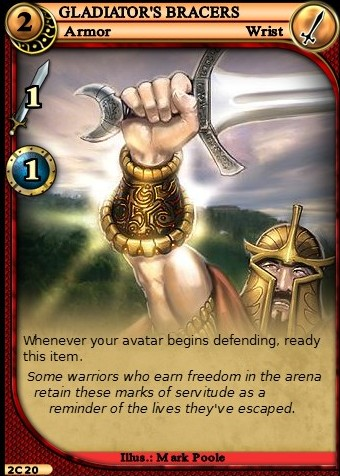
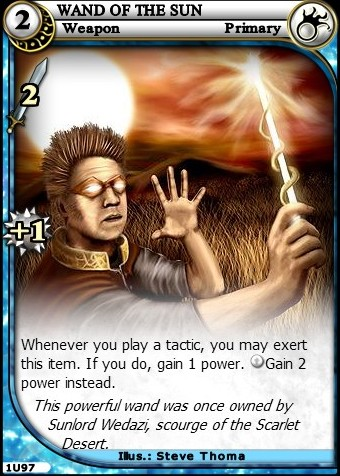
I decided to show you two items because there are a few different things you can find on items that aren't always on all items.
First, in the top left corner, we again have the cost and faction. Both these items cost 2 Power. The peach circle around the 2 on the Gladiator's Bracers represents neutral faction alignment while the white circle around the 2 on the Wand of the Sun represents Light faction.
The top right corner again shows us what archetype can play these cards. Wand of the Sun is a Mage card while the Bracers are for Fighters.
In the line below the title on this card we have some information about the items. Gladiator's Bracers are armor while the Wand of the Sun is a weapon. Some other possibilities in this area are Mount and Charm. In addition to the item type, to the right is the slot the item fills. The Wand is a primary weapon while the Bracers are wrist armor. You can only have one card equipped per slot. However, if you play a second card for a slot that is already filled, you can destroy one of the conflicting items to draw a card. This is a nice bonus when you draw more than one of a specific item.
Down the left side of the card we have some familiar icons. The first is the attack value of the item, represented by the sword. When your avatar is attacking, you can exert an item to add its attack value to your total attack. Not all items will have an attack value.
The next icon is the defense value, represented by the shield. When your avatar is defending, you can exert an item to add its defense value to your total defense. Not all items will have a defense value.
Next, there is the damage bonus, represented by the spiked ball. When your avatar wins or ties a combat, you can exert an item to add its damage bonus to your total damage. Not all items will have a damage bonus.
Finally, we again have the text box. Notice again that the Wand of the Sun has an extra benefit if you get to Light faction.
Units
The next card type is the unit. Let's take a look.
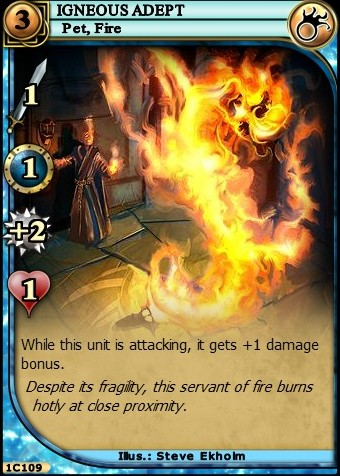
Units are one of the main ways you will be dealing damage in Legends of Norrath. There are several icons here, but most of them are the same as the avatar's.
In the top left corner, we have the cost. The Igneous Adept here costs 3 power to play. The circle around the cost again represents faction with this card being neutral. In the top right is the archetype. At this point in the game, most units are generic meaning any archetype can play them. The only exceptions are Mage pets. In addition to the cost, units also have a faction. This unit is neutral, but there are also Shadow and Light units.
Down the left side of the card are the combat values. First is the attack value shown by the sword. When the unit is involved in a raid, you may exert it to add its attack value to your total attack.
Below the attack is the defense value shown by the shield. When a unit is defending, you may exert it to add its defense value to your total defense.
After the defense is the damage bonus, shown by the spiked ball. When a unit wins or ties a combat, you can exert it to add its damage bonus to your total damage.
Finally, there is the health, shown by the heart. When a unit takes damage, the unit's health is reduced by that amount. When its health reaches zero, the unit dies.
Units also have text in their text box like most other cards. Units have the most varied abilities in their text box, so make sure to read through them.
Tactics
Finally, we have tactics. Here's an example.
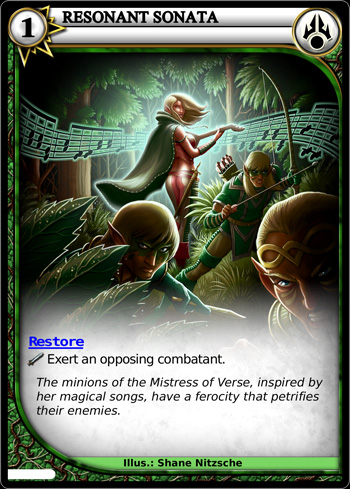
The top left corner again has the cost. Many tactics have no cost. If there is no number the cost is simply zero. Tactics also have faction. By now, you should probably be able to realize that the little white circle around the cost means this is a Light faction card.
The top right is again the archetype icon. This is a Scout card.
Unlike other cards, tactics don't stay in play after you play them. They are a one shot type of effect so there is nothing else to look for on tactics other than the text box. Tactics are only playable during combat and there will be an icon in the text box to tell you when you can play one. A sword means you can play it when attacking. A shield means you can play it when defending. Both means you can play it when attacking or defending.
|
